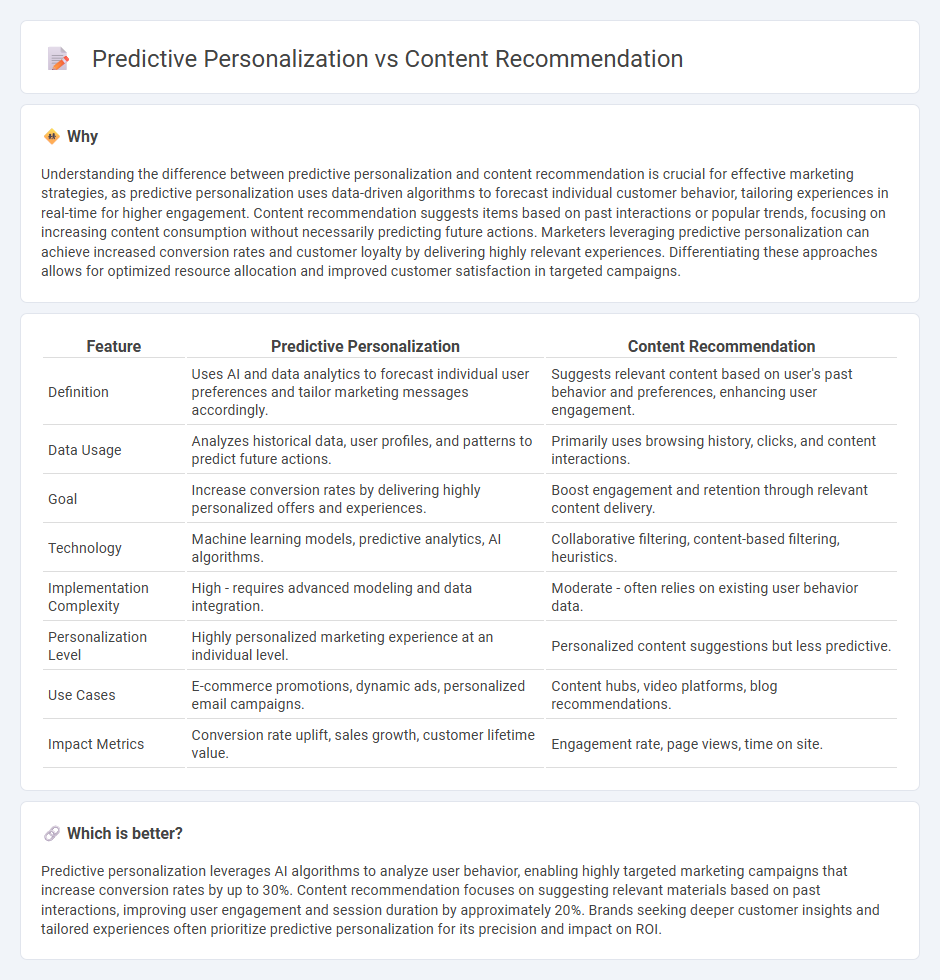
Predictive personalization uses data analytics and machine learning algorithms to tailor marketing messages based on individual consumer behaviors and preferences, enhancing engagement and conversion rates. Content recommendation, on the other hand, employs user interaction data to suggest relevant content, aiming to improve user experience and drive sustained interest. Explore more insights to understand how these strategies can transform your marketing approach.
Why it is important
Understanding the difference between predictive personalization and content recommendation is crucial for effective marketing strategies, as predictive personalization uses data-driven algorithms to forecast individual customer behavior, tailoring experiences in real-time for higher engagement. Content recommendation suggests items based on past interactions or popular trends, focusing on increasing content consumption without necessarily predicting future actions. Marketers leveraging predictive personalization can achieve increased conversion rates and customer loyalty by delivering highly relevant experiences. Differentiating these approaches allows for optimized resource allocation and improved customer satisfaction in targeted campaigns.
Comparison Table
| Feature | Predictive Personalization | Content Recommendation |
|---|---|---|
| Definition | Uses AI and data analytics to forecast individual user preferences and tailor marketing messages accordingly. | Suggests relevant content based on user's past behavior and preferences, enhancing user engagement. |
| Data Usage | Analyzes historical data, user profiles, and patterns to predict future actions. | Primarily uses browsing history, clicks, and content interactions. |
| Goal | Increase conversion rates by delivering highly personalized offers and experiences. | Boost engagement and retention through relevant content delivery. |
| Technology | Machine learning models, predictive analytics, AI algorithms. | Collaborative filtering, content-based filtering, heuristics. |
| Implementation Complexity | High - requires advanced modeling and data integration. | Moderate - often relies on existing user behavior data. |
| Personalization Level | Highly personalized marketing experience at an individual level. | Personalized content suggestions but less predictive. |
| Use Cases | E-commerce promotions, dynamic ads, personalized email campaigns. | Content hubs, video platforms, blog recommendations. |
| Impact Metrics | Conversion rate uplift, sales growth, customer lifetime value. | Engagement rate, page views, time on site. |
Which is better?
Predictive personalization leverages AI algorithms to analyze user behavior, enabling highly targeted marketing campaigns that increase conversion rates by up to 30%. Content recommendation focuses on suggesting relevant materials based on past interactions, improving user engagement and session duration by approximately 20%. Brands seeking deeper customer insights and tailored experiences often prioritize predictive personalization for its precision and impact on ROI.
Connection
Predictive personalization leverages data analytics and machine learning algorithms to anticipate customer preferences, enabling tailored marketing strategies that increase engagement and conversion rates. Content recommendation systems utilize these predictive insights to deliver highly relevant and timely content, enhancing user experience and fostering brand loyalty. Integrating predictive personalization with content recommendations optimizes marketing efforts by aligning messaging with individual consumer behavior patterns and intent signals.
Key Terms
**Content Recommendation:**
Content recommendation leverages algorithms to analyze user behavior, preferences, and interactions, delivering tailored content that maximizes engagement and relevance. By utilizing collaborative filtering, content-based filtering, or hybrid models, it effectively drives user retention and satisfaction through personalized suggestions. Explore how advanced content recommendation systems can transform your user experience and boost conversion rates.
Relevance
Content recommendation leverages user behavior and preferences to suggest relevant items, enhancing engagement by matching interests accurately. Predictive personalization uses advanced algorithms and data analysis to anticipate unique user needs, delivering tailored experiences before explicit preferences are expressed. Explore how combining both approaches can maximize relevance and boost user satisfaction.
Algorithm
Content recommendation algorithms analyze user behavior and preferences to suggest relevant items, leveraging collaborative filtering and content-based filtering techniques. Predictive personalization algorithms use machine learning models to forecast future user actions and tailor experiences proactively, often incorporating real-time data and predictive analytics. Explore the differences in algorithmic approaches to enhance your understanding of personalized digital strategies.
Source and External Links
What is Content Recommendation? All You Need To Know - Content recommendation is the tactic of suggesting content to website visitors based on factors such as popularity, relevance, user profile, interests, or preferences, aiming to boost engagement, decrease bounce rate, and increase time spent on site by promoting related articles or pages.
What is a content recommendation engine? - Optimizely - Content recommendation engines use algorithms to decide what content to recommend to individual users by blending collaborative and content-based filtering, exemplified by platforms like Netflix, and apply to blog articles, product suggestions, videos, and email campaigns to deepen user engagement.
What is content recommendation in media? - Algolia - Media content recommendation systems use AI-driven algorithms to personalize content for users based on consumer data and trending topics, enhancing user engagement and loyalty by tailoring suggestions to demographics, viewership, and search history.
 dowidth.com
dowidth.com